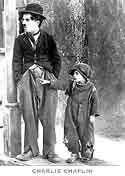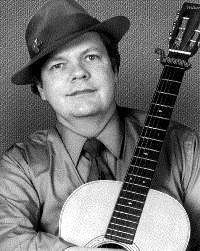Stanley Jordan
 Stanley Jordan, born in Chicago, 1959, started as a youngster to play the guitar is rock and soul groups. He studies electronic music at Princeton University and played with Dizzy Gillespie and Benny Carter. His first record was commercially not a success, although he showed his virtuosity to the world.
Stanley Jordan, born in Chicago, 1959, started as a youngster to play the guitar is rock and soul groups. He studies electronic music at Princeton University and played with Dizzy Gillespie and Benny Carter. His first record was commercially not a success, although he showed his virtuosity to the world.He loves to play his guitar as shown on the pictures with both hands tapping the strings of the instrument. It gives him the opportunity to play two independent lines and to accompany his own solos. It sounds a bit like the technique Oscar Aleman used to combine the solo pickings and rhythms in one instrument at the same time. This touch, or two-handed tapping technique is described in his home page you can visit by clicking on the title bar.

To be honest - I had never heard him playing and the Blue Note album Live in New York made me anxious to hear more of him. It is a transcription of a live recording in Manhattan Center, New York City, 21st of March 1989 and he is accompanied by two trios with names as Kenny Kirkland p, Charnett Moffett b, Jeff Watts dm and Bernard Wright p, Yossi Fine b, J.T. Lewis dm.
If you have to opportunity try to get one of his recordings and listen to his marvelous guitar playing technique, or better try to join a concert. His next one will be at the Phiippines, I guess.
Listen to a fragment of Impressions, the first track on the album.
Nederlands ( To the English translation )

Stanley Jordan, geboren in 1959 in Chicago, begon als jong volwassene te spelen in Rock en Soul bandjes. Hij studeerde electronische muziek op de Princeton Universiteit en speelde met Dizzy Gillespie en Benny Carter. Zijn eerste plaat, een sologitaar-plaat, flopte, maar dat lag zeker niet aan zijn fabuleuze gitaar techniek.
Hij houdt ervan de gitaar te bespelen zoals te zien op de foto's. Beide handen bespelen de snaren op de hals van de gitaar. Dat geeft de mogelijkheid om twee aparte melodielijnen te creëren, zodat het lijkt alsof hij zichzelf begeleidt. Het lijkt een beetje op de techniek die Oscar Aleman toepaste, waarbij hij in staat was op zijn gitaar zowel de melodielijnen als de ritmebegeleiding tegelijkertijd te spelen. Dat geeft een heel rijk gitaargeluid. Stanley beschrijft deze techniek uitgebreid op zijn homepage, die je vindt door op de titelkop te klikken.

Om eerlijk te zijn - ik had hem nog nooit horen spelen en het Blue Note album Live in New York smaakt naar meer. Het is een opname van een live concert opgenomen op 21 maart 1989 in het Manhattan Center in New York City en Stanley wordt begeleid door twee trio's: Kenny Kirkland p, Charnett Moffett b, Jeff Watts dm en Bernard Wright p, Yossi Fine b, J.T. Lewis dm.
Als je de kans krijgt moet je zeker proberen hem live te horen spelen, denk ik. Zijn fabelachtige gitaartechniek is binnenkort te beluisteren op de Filipijnen geloof ik, dus wat let je .....
Luister naar een fragment van Impressions, het eerste nummer van de plaat.
Hans Koert




































